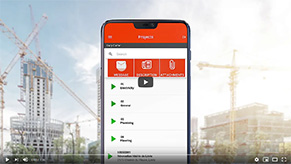
29 October, 2025
Mobile-Punch
SHARE
How to improve communication on construction sites
Communication in construction represents one of the major challenges faced by contractors and project managers. Communication problems between teams are a leading cause of failure in construction projects. This issue costs companies millions of dollars annually and jeopardizes safety on job sites.
Improving communication on-site goes beyond installing more advanced equipment. It requires a comprehensive approach that incorporates mobile technologies, team training, and process optimization. Companies that invest in effective communication solutions see a 25% reduction in project delays and a significant decrease in workplace accidents.
Communication challenges in construction
Impact of poor communication on productivity
The consequences of poor communication in the construction industry manifest in multiple ways. Errors in information transmission lead to rework, which can account for up to 15% of a project’s total budget. These hidden costs include not only wasted materials but also overtime hours needed to correct mistakes.
In Quebec, CNESST regulatory specifics add another layer of complexity. Companies must maintain accurate documentation of hours worked, mandatory breaks, and safety conditions. Inadequate communication can result in costly non-compliance and significant penalties.
Team morale is another critical factor. Workers who don’t receive clear instructions or updates about task timesheet changes often feel frustrated, which directly affects productivity. This situation contributes to the high turnover rate observed in the construction sector.
Common barriers to effective communication
The construction work environment presents unique challenges for communication. Equipment noise, difficult weather conditions, and the geographic dispersion of teams complicate information exchanges. These environmental factors require robust, tailored communication solutions.
The diversity of trades on a single site also creates communication obstacles. Electricians, plumbers, carpenters, and other specialists often use technical jargon that can cause misunderstandings. This issue is compounded when teams include workers from different generations with varying levels of technological comfort.
Seasonal challenges, like those encountered in Canada, add another dimension. Winter conditions limit the use of traditional electronic devices and require weather-resistant solutions. This constraint directly influences the choice of communication tools deployed on-site.
Strategies to optimize on-site communication
Establish clear and structured communication channels
Creating a communication chart is the first step toward sustainable improvement. Each team member must know exactly whom to contact based on the type of information to be shared. This structure avoids duplication and ensures that critical messages reach the right people quickly.
Emergency protocols deserve special attention in the Quebec context. In accordance with CNESST requirements, every site must have clear procedures for reporting incidents and coordinating emergency responses. These protocols should be regularly tested and updated based on evolving regulations.
Examples of internal information transmission procedures by situation:
| Type of Information | Responsible | Transmission deadline | Preferred channel |
| Safety emergency | Foreman | Immediate | Radio/ Phone |
| Schedule modification | Project Manager | 24h in advance | Mobile application |
| Daily report | Supervisor | End of day | Centralized system |
| Material request | Logistics Manager | 48h in advance | Digital form |
| Internal communication | All employees / HR | Weekly or as needed | Internal communication tool |
Adopt technological tools suited to mobile teams
Mobile applications specifically designed for construction are revolutionizing site management. These solutions enable real-time activity tracking, even in areas with limited network connectivity. Offline functionality is a key advantage for remote or underground sites.
Built-in geolocation features offer significant added value. They allow automatic verification of employee presence on-site and help optimize team allocation based on needs. This also improves safety by identifying the location of the last punches.
Integration with existing accounting systems significantly simplifies administrative management. Hours worked, materials used, and project progress are automatically synced, reducing data entry errors and speeding up billing processes.
Train teams in communication best practices
Ongoing team training is essential for improving site communication. Training programs should be tailored to the different levels of tech literacy present on the site. A gradual approach helps guide all workers effectively in adopting new tools.
Developing communication skills goes beyond technical tool usage. It includes awareness of the importance of accurate documentation, constructive conflict management, and collaborative problem-solving techniques. These cross-cutting skills greatly enhance team efficiency.
Examples of communication skill development:
- Initial training: introduction to communication tools and procedures
- Advanced sessions: skill updates and new features
- Personalized support: one-on-one help for less tech-savvy users
- Ongoing assessment: measuring effectiveness and making necessary adjustments
Technological solutions for site communication
Advantages of mobile apps for construction
Specialized mobile solutions are radically transforming project management in construction. Unlike general-purpose tools, these apps incorporate industry-specific features. With clear, structured communication channels, it’s easier to centralize discussions:
- General channel for announcements and overall information
- Project-specific channels to group discussions by site
- Response options to add clarity: emojis, direct replies, photo sharing, and more
- Media galleries to share photos, videos, plans, and documents directly from the site
These features ensure better traceability of exchanges, enhanced collaboration, and significant time savings in project coordination.
Real-time centralization of project information eliminates data silos that hinder efficiency. All stakeholders access the same updated information, reducing misunderstandings and speeding up decision-making. This transparency allows everyone to track project progress.
Geolocated punch-ins are a major innovation for companies managing mobile teams. This feature ensures accurate attendance data while simplifying administrative processes. Managers can focus on strategic tasks instead of manually verifying timesheets.
Essential features of a construction communication tool
The user interface is the key factor for successful adoption of a communication tool in construction. A simple, intuitive interface allows workers of all ages and tech levels to use the app effectively. This simplicity must not compromise the functional depth required for comprehensive management.
Automatic data syncing ensures consistent information across all users. This is especially critical in environments with intermittent network connections.
Measure and continuously improve communication
Key Performance Indicators (KPIs) to track
Measuring the effectiveness of communication on construction sites requires precise and relevant KPIs. Payroll error reduction is an immediately quantifiable indicator that reflects improved data accuracy. More transparent and reliable communication leads to fewer disputes over hours worked.
Project delays caused by communication issues are another critical metric. Effective communication should reduce these delays, leading to substantial savings. This improvement also results in better customer satisfaction and a stronger reputation in the market.
Implement a continuous feedback system
Regularly collecting team feedback helps quickly identify areas for improvement in the communication system. These feedbacks must be structured and systematically analyzed to guide future developments. A proactive approach to gathering this feedback shows the company’s commitment to continuous improvement.
Process adjustments based on field needs ensure alignment between deployed tools and operational realities. This flexibility is a major competitive advantage, especially in a sector where working conditions constantly evolve.
Evolving tools based on client demands maintains the long-term relevance of the solution. Companies that invest in scalable solutions gain a lasting advantage over competitors using rigid systems.
Frequently Asked Questions
What are the implementation costs of a modern on-site communication system?
Costs vary based on company size and chosen features. The initial investment includes training and setup but quickly pays off through reduced payroll errors and improved productivity.
How can adoption be ensured among less tech-savvy workers?
Successful adoption relies on gradual training and personalized support. It’s essential to demonstrate concrete benefits for each user and maintain accessible technical support. Involving team leaders in the deployment process greatly facilitates acceptance by the entire workforce.
How long does it typically take to see measurable improvements?
Improvements are usually noticeable within the first 2-3 weeks, particularly in time-tracking accuracy. Full benefits, including process optimization and reduced delays, typically emerge after 2-3 months of regular use.
Do mobile solutions work in areas without network coverage?
Modern construction management apps like Mobile-Punch include offline features that allow time punches even without internet connectivity. Data is automatically synced once the device regains connection, ensuring operational continuity in all environments.






